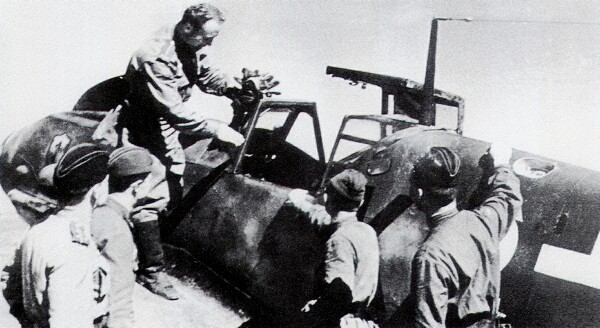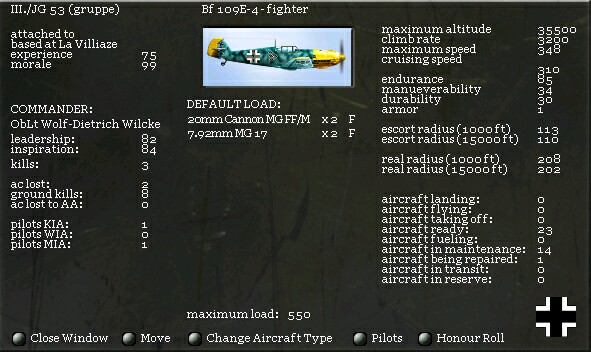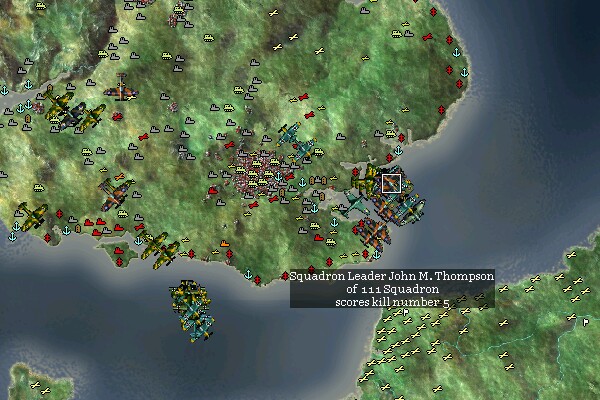
I think at some point in this series I promised you some role-playing. Strategy role-playing, to be exact. Not by me, of course, because I don’t do that kind of stuff. But from a game design perspective, you can’t help but appreciate the possibilities. Because the best games tell the best stories, the chance to tell a good one shouldn’t be missed. From a strategy role-playing perspective, what could be a better story than what I’m about to show you?
From Stephen Bungay’s book, which quotes a letter from a young German pilot.
On 17 August, a few days after the assault on the British mainland had begun, Leutnant Hans-Otto Lessing, a fighter pilot with II./JG51, wrote home to his parents. The previous day, he had scored his fifth kill. This was, he wrote, the hundredth victory of his wing:
And of these Hauptmann Tietzen, my Staffel commander alone has nineteen! I witnessed most of his kills. It is fantastic, the way he shoots. He is the boss, he moves us into position and selects the victims, and we have to do little more than cover him. There is a wonderful sense of teamwork in the Staffel. With his twentieth victory, the Ritterkreuz will be due. For me, the award of the Iron Cross, First Class, has been imminent since my fourth kill.Our own losses are only moderate. Seven in the entire Gruppe, and of these three certainly survive in captivity. We are in the Geschwader of Major Molders, the most successful Geschwader. Ours is the most successful Gruppe and our 5th Staffel, with thirty-seven victories, the most successful Staffel.
During the last few days the British have been getting weaker, though individuals continue to fight well. Often the Spitfires give beautiful displays of aerobatics. Recently I had to watch in admiration as one of them played a game with thirty Messerschmitts, without itself ever getting into danger; but such individuals are few. The Hurricanes are tired old “puffers”.
This is only a short letter. One would have to write a book to give even a brief picture of events. I am having the time of my life. I would not swap places with a king. Peacetime is going to be very boring after this!
Your
Hans-Otto
What a brash yet naive and instantly humanizing letter. The first thing any storytelling game tries to do is make you care about the characters. In wargames, individual units become characters not because of their constitution or charisma or +2 chainmail, but because they’re identifiable and recognizable and you are invested in their performance. My King Tiger tank in the Tom vs. Bruce Combat Mission episode was far more memorable to me than a platoon of Andrew Ryans or “Jack” whoevers. The Battle of Britain had memorable personalities and personality conflicts. It’s the kind of hook the best role-playing game desperately wishes it had. Eagle Day had it, if it wanted. But it just left me begging the question: Where is my Hans-Otto Lessing, or my Horst Tietzen?
Last time we talked about unsatisfying combat mechanics. I’m sure your eyes are still glazed over from that one. But even combat mechanics can carry engaging information. The best game designs use every element to push an agenda. It’s not clear what Eagle Day’s agenda is, but it isn’t exactly historical “flavor” or personality.
By contrast, in the actual Battle (and the Luftwaffe in general) had a ton of color and historical flavor. In his chapter simply entitled “The Men,” Stephen Bungay explains Luftwaffe traditions.
Having to reinvent itself anew in 1935, it looked back to the famous individuals of World War I as its source of inspiration. Every unit had its own insignia, even down to the level of the Staffel, and whilst some Geschwader were given emblematic names like ‘Edelweiss’ (KG51) or Lowe (‘Lion’ — KG26), others were named after the great men of the past such as ‘Immelman’ (StG2) and, of course, ‘Richthofen’ (JG2). Being new, the Luftwaffe was also easier to politicize and other units were named after Nazi heroes like ‘Schlageter’ (JG26) or ‘Horst Wessel’ (ZG26).
Pick up a copy of SSG’s seminal The Ardennes Offensive and you’ll see individual unit emblems reproduced for each division. It does nothing for gameplay and everything for the game. It’s also a title from about the same time as the original Battle of Britain. The late, great Ian Trout knew what made wargamers tick.
How important was this stuff? Important enough that Bungay relates this story.
Goring was quite prepared to pursue petty feuds to the detriment of morale. He disapproved of the Kommodore of JG53, Hans-Jurgen von Cramon-Taubadel, because he had married into a family whose Aryan credentials were less than perfect. So in July, he ordered the unit to paint out its “Ace of Spades” insignia, of which it was very proud. They painted red bands around their cowlings instead. In retaliation, when Wolf-Dietrich Wilcke took over III./JG53 in August, he had the Swastikas on the tails of his Bf 109s painted out, which was both an expression of solidarity with his Kommodore and a signal to Goring. His standing was very low within JG53. They got their Ace of Spades insignia back on 20 November.
The main point of this quote is, how great a name is “Hans-Jurgen von Cramon-Taubadel?” Just kidding. It goes without saying that it’s a great name. The main point is that things like unit insignias weren’t just window dressing for pilots, and while I wouldn’t support any kind of “Hermann Goring disapproves of your wife” role-playing mechanic in a Battle of Britain game, this is exactly the kind of game flavor that doesn’t take much to include. But then look at the general info screen for III. Gruppe of Jagdgeschwader 53 (III./JG53).

Besides the fact that it is commanded by Oberleutnant Wolf-Dietrich Wilcke (historically accurate!) I don’t get a lot of satisfaction out of that screen. There is a bunch of data on the Bf 109E-4, which doesn’t help me in the game that much, and is common to all units flying that aircraft type. Plus, the aircraft has yellow cowling paint, which wasn’t the norm at this time, or for this unit. (Tim Stone is just shaking his head sadly and knowingly.) Is there an ace of spades on the cowling? No, there is not.
If you’re laughing, imagine how annoyed you are when your matching set of Plate Mail of the Rhododendron doesn’t show up on your character graphically other than in the inventory, where it just has a generic “armor” icon. Good design is attention to detail.
Here’s some properly done historical flavor for you from the Internet. Note the “Ace of Spades” on the cowling.

I know it’s a G-model in North African camouflage. Work with me, please.
I’m well aware of the fact that for most people this is total junk. But most people aren’t playing a computer game where you spend most of your time watching an imaginary Luftwaffe. For those people who are, they’re left trying to touch history through about three feet of scratched Plexiglass. My best pilot is currently in II./JG51. While on a “free hunt” over southern England, it engages a flight of Spitfires. Oh look, a message: “II./JG51 bouncing enemy fighters with 1 x Bf 109E-4.” Really? Which pilot? Oh there’s more: “1 x Spitfire IA destroyed.” Really? Which pilot?
Ok, sometimes the game does tell me stuff. Like the time shown below. Except it’s about the British, and I’m playing the Germans. Hey Eagle Day, thanks for rubbing my nose in it, but I’m not that big a fan of the other team.

But the main point is that you don’t get attached to your units because they’re all homogenized, and that’s a major departure from history. Bungay spends a lot of time on this.
The Luftwaffe was out to create warrior-heroes. Its clinging to a pseudo-knightly ethos was just as archaic as the class distinctions in the RAF, but given a modern twist. It encouraged score-chasing by individual pilots and Goebbels used them as propaganda material. During the Battle, the rivalry between the contenders for the number one spot, Molders, Galland and Wick, became intense, and the Luftwaffe newspaper Signal published voluminous photos and articles about their exploits.
Eagle Day’s failure as a simulation is also its biggest failure as a strategy role-playing game, and that’s exactly this lack of warrior-heroes.
The Luftwaffe’s Erich Hartmann, the top-scoring ace of the entire war, was credited with over 350 victories. The Germans had over one hundred pilots with 100 or more kills. By contrast, the highest-scoring American pilot, Richard Bong, had 40. There are lot of reasons for this, not the least of which is the fact that so many Luftwaffe victories occurred on the Eastern Front where kills were supposedly “easier” (the point-scoring system for decorations awarded different credit for kills depending on whether they were against the Western Allies or the Russians), but regardless of the factors involved, this makes the pilots themselves larger than life. Heroes, in a sense. Which would make them fit into a heroic role-playing game.
Back when I was reading and writing game reviews, I particularly hated the ones where the author singled out all the design decisions he or she disagreed with, and then criticized the game for not being some other, theoretical game with different design choices that only existed in his or her head. I still dislike them, although looking back, I’m sure I was guilty of that a few times. Which is my disclaimer for the next paragraph, which is going to do exactly that.
I actually take that back, because this isn’t a design decision. It’s an ahistorical game effect which robs the game of an otherwise crucial hook. Nothing in the game design precludes certain pilots from racking up big kill scores. They just don’t. The Luftwaffe system encouraged the leaders (who flew in the Stabschwarm, or headquarters flight) to score a disproportionate number of victories. Bungay elaborates.
When out hunting, the leader had only one job: to find victims for himself and his hunting pack. When victims were found, the leader was the one to go for them, which in part explains the high scores built up by Germany’s leading aces, the “Experten”.
The rise of the Experten (experts) like Adolf Galland and Werner Molders gives the Battle a lot of its character. The British had their own famous aces, but the culture of the RAF discouraged individual glory-seeking. Not so in the Luftwaffe, as Bungay continues.
At the beginning of the battle, Galland’s Katschmarek [wingman] was the superb young pilot Joachim Muncheberg. During this period he got four victories, which was considered outstanding for a wingman. On 22 August, when Galland took over the whole Geschwader, he gave in to pressure from Muncheberg and made him the leader of the 7th Staffel. Thereupon Muncheberg’s score rose to twenty by mid-September, which got him the Ritterkreuz [Knight’s Cross], and by the time of his death in March 1943, stood at 135.
In my game, one pilot — Hans John of II./JG51 (the “Edelweiss” Geschwader, although you wouldn’t know it from the game) — has four kills. Three pilots have three. And then there are pages and pages of pilots with one or two victories. It seems like everybody in my imaginary air force has shot down at least one plane. Which, according to an entire chapter in Bungay’s book, is exactly not the way it should be.*
In 1966, an American, Herbert K. Weiss, collated and analysed some historical data and published it in an article called “Systems Analysis Problems of Limited War”. He concluded that 90% of pilots had only a 50:50 chance of getting through their first decisive combat without being shot down. After five decisive encounters their survival chances increased by a factor of twenty. Further data suggests that only about 5% of pilots score more than five or more victories (thus becoming “aces”) but that these 5% score about 40% of all victories claimed in the air. This data remains consistent across all the campaigns he analysed in the two World Wars and Korea.
The Battle of Britain is no exception. Between 1 July and 31 October 1940, RAF pilots made 2,698 claims, an average of just one for each of the 2,927 pilots who officially flew in the campaign. Examination of the claims made by the aces, defined as all those making five or more claims over the period reveals that these 104 pilots made 806 claims between them. This top 3.5% of pilots therefore made about 30% of claims, broadly in line with Weiss’ findings.
This means that even if you don’t make national heroes out of your fighter aces, there still will be a few pilots with a lot of victories, and a lot of pilots with none. This simply does not happen in Eagle Day.
As a designer, how do you not do this?
As I said at the outset, the best games tell the best stories. The Battle of Britain had so many. Here’s the end of the one that opened this piece. The fact that Eagle Day never strives for this is by far its worst sin. Like it’s not even close.
Hans-Otto need not have worried about becoming bored in peacetime. The following afternoon, at 1735, together with his admired boss, Horst Tietzen, Hans-Otto Lessing was killed by a “tired old ‘puffer’”. They went down into the sea off Whitstable, the victims of two Polish pilots of 501 Squadron, which flew Hurricanes. Tietzen’s body was washed up on the coast some time later. He had a single bullet wound to the head and his pistol was missing. Hans-Otto was never found.
________________________________________
*Bungay’s reference is a little misleading. I did some searching and found the original paper, which you can find here in poor photocopy form. Weiss defines “decisive encounter” to mean a combat in which you score a kill or are killed yourself. The data to which Bungay refers is actually presented in Figure 16 (on page 307), and he misinterprets (or misstates) it. What he should have said was that 90% (actually 85%) of pilots had no better than a 50% chance of surviving their first decisive encounter. What is probably more remarkable about that chart is that a full 75% of pilots had a 90% or more chance of not surviving their first decisive combat. The point Weiss is making is that there is a tiny minority of pilots who truly are the hunters, and the vast majority are the hunted.
Discussion
No comments yet.